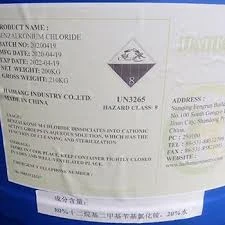Feb . 12, 2025 10:56
Back to list
chloro isothiazolinone
Isothiazolinones are a class of synthetic organic compounds widely used as preservatives in a range of consumer products, including cosmetics, personal care items, and industrial applications. With concerns about allergies and sensitivities, understanding the different nomenclatures and applications of isothiazolinones is crucial for both manufacturers and consumers aiming for safe product choices.
The breadth of isothiazolinones’ applications spans multiple sectors, each carefully considering safety thresholds to align with regulatory standards. In the cosmetics and personal care industry, isothiazolinones help maintain product shelf-life. However, they are often restricted to rinse-off products like shampoos and conditioners due to skin sensitivity concerns. In paints and coatings, isothiazolinones prevent microbial deterioration, ensuring longevity and performance. For water-based formulations susceptible to microbial growth, these biocides are integral, though manufacturers must comply with environmental regulations due to potential aquatic toxicity. Addressing Safety Concerns The rise in reported allergic reactions linked to isothiazolinones has propelled demand for alternative formulations and heightened scrutiny of labeling practices. The European Commission has implemented stringent regulations, limiting permissible concentrations in certain applications, and the cosmetics industry has seen a shift toward preservation systems with reduced potential for allergenic responses. The growing trend towards transparency and consumer advocacy has underscored the necessity for brands to adopt clear labeling practices. Listing all ingredients, including isothiazolinone derivatives, empowers consumers to make informed choices, directly impacting brand trustworthiness and consumer loyalty. Future Insights and Developments The pursuit of safer preservation methods continues to drive innovation within the chemical industry. Research into naturally derived preservatives and alternative synthetic compounds aims to balance efficacy with reduced dermatological risks. As brands transition towards eco-friendly formulations, consumer demand for transparency and safety in product ingredients will likely shape future regulations and industry practices. In the evolving landscape of biocides, maintaining expertise in chemical nomenclature and regulatory compliance is paramount. For industries reliant on isothiazolinones, aligning products with consumer expectations and regulatory guidelines ensures long-term success and credibility in global markets. The ongoing dialogue between industry leaders, regulatory bodies, and consumers will continue to refine the role of isothiazolinones in maintaining health and sustainability standards across diverse applications.


The breadth of isothiazolinones’ applications spans multiple sectors, each carefully considering safety thresholds to align with regulatory standards. In the cosmetics and personal care industry, isothiazolinones help maintain product shelf-life. However, they are often restricted to rinse-off products like shampoos and conditioners due to skin sensitivity concerns. In paints and coatings, isothiazolinones prevent microbial deterioration, ensuring longevity and performance. For water-based formulations susceptible to microbial growth, these biocides are integral, though manufacturers must comply with environmental regulations due to potential aquatic toxicity. Addressing Safety Concerns The rise in reported allergic reactions linked to isothiazolinones has propelled demand for alternative formulations and heightened scrutiny of labeling practices. The European Commission has implemented stringent regulations, limiting permissible concentrations in certain applications, and the cosmetics industry has seen a shift toward preservation systems with reduced potential for allergenic responses. The growing trend towards transparency and consumer advocacy has underscored the necessity for brands to adopt clear labeling practices. Listing all ingredients, including isothiazolinone derivatives, empowers consumers to make informed choices, directly impacting brand trustworthiness and consumer loyalty. Future Insights and Developments The pursuit of safer preservation methods continues to drive innovation within the chemical industry. Research into naturally derived preservatives and alternative synthetic compounds aims to balance efficacy with reduced dermatological risks. As brands transition towards eco-friendly formulations, consumer demand for transparency and safety in product ingredients will likely shape future regulations and industry practices. In the evolving landscape of biocides, maintaining expertise in chemical nomenclature and regulatory compliance is paramount. For industries reliant on isothiazolinones, aligning products with consumer expectations and regulatory guidelines ensures long-term success and credibility in global markets. The ongoing dialogue between industry leaders, regulatory bodies, and consumers will continue to refine the role of isothiazolinones in maintaining health and sustainability standards across diverse applications.
Share
Next:
Latest news
-
Water Treatment with Flocculant Water TreatmentNewsJun.12,2025
-
Polymaleic AnhydrideNewsJun.12,2025
-
Polyaspartic AcidNewsJun.12,2025
-
Enhance Industrial Processes with IsothiazolinonesNewsJun.12,2025
-
Enhance Industrial Processes with PBTCA SolutionsNewsJun.12,2025
-
Dodecyldimethylbenzylammonium Chloride SolutionsNewsJun.12,2025





